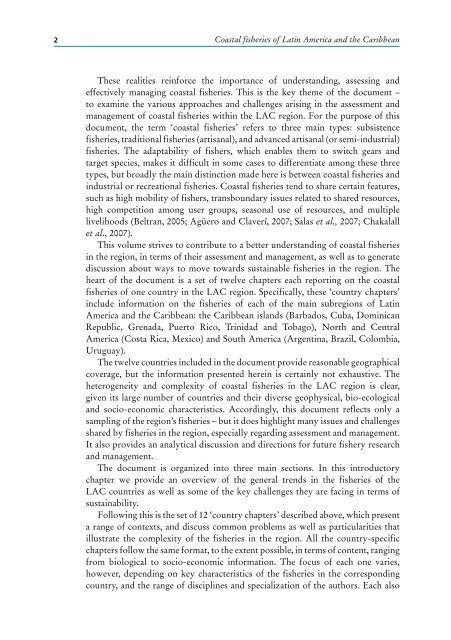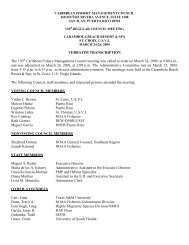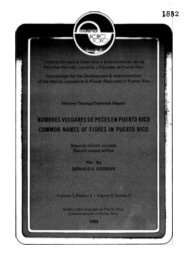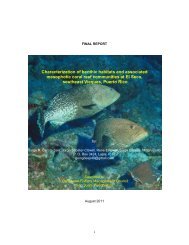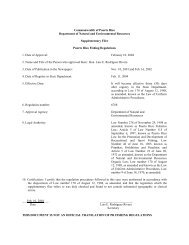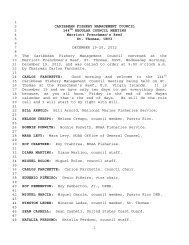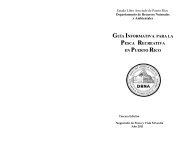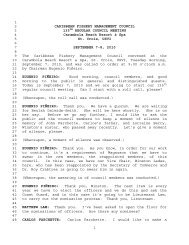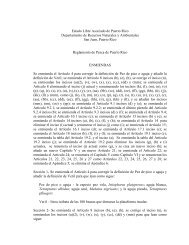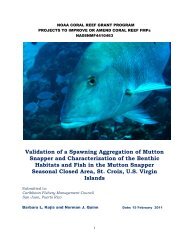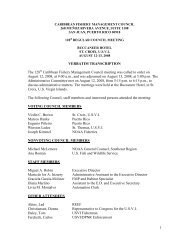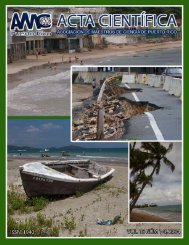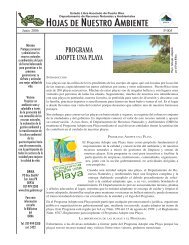Coastal fisheries of Latin America and the Caribbean
Coastal fisheries of Latin America and the Caribbean
Coastal fisheries of Latin America and the Caribbean
You also want an ePaper? Increase the reach of your titles
YUMPU automatically turns print PDFs into web optimized ePapers that Google loves.
2<strong>Coastal</strong> <strong>fisheries</strong> <strong>of</strong> <strong>Latin</strong> <strong>America</strong> <strong>and</strong> <strong>the</strong> <strong>Caribbean</strong>These realities reinforce <strong>the</strong> importance <strong>of</strong> underst<strong>and</strong>ing, assessing <strong>and</strong>effectively managing coastal <strong>fisheries</strong>. This is <strong>the</strong> key <strong>the</strong>me <strong>of</strong> <strong>the</strong> document –to examine <strong>the</strong> various approaches <strong>and</strong> challenges arising in <strong>the</strong> assessment <strong>and</strong>management <strong>of</strong> coastal <strong>fisheries</strong> within <strong>the</strong> LAC region. For <strong>the</strong> purpose <strong>of</strong> thisdocument, <strong>the</strong> term ‘coastal <strong>fisheries</strong>’ refers to three main types: subsistence<strong>fisheries</strong>, traditional <strong>fisheries</strong> (artisanal), <strong>and</strong> advanced artisanal (or semi-industrial)<strong>fisheries</strong>. The adaptability <strong>of</strong> fishers, which enables <strong>the</strong>m to switch gears <strong>and</strong>target species, makes it difficult in some cases to differentiate among <strong>the</strong>se threetypes, but broadly <strong>the</strong> main distinction made here is between coastal <strong>fisheries</strong> <strong>and</strong>industrial or recreational <strong>fisheries</strong>. <strong>Coastal</strong> <strong>fisheries</strong> tend to share certain features,such as high mobility <strong>of</strong> fishers, transboundary issues related to shared resources,high competition among user groups, seasonal use <strong>of</strong> resources, <strong>and</strong> multiplelivelihoods (Beltran, 2005; Agüero <strong>and</strong> Claverí, 2007; Salas et al., 2007; Chakalallet al., 2007).This volume strives to contribute to a better underst<strong>and</strong>ing <strong>of</strong> coastal <strong>fisheries</strong>in <strong>the</strong> region, in terms <strong>of</strong> <strong>the</strong>ir assessment <strong>and</strong> management, as well as to generatediscussion about ways to move towards sustainable <strong>fisheries</strong> in <strong>the</strong> region. Theheart <strong>of</strong> <strong>the</strong> document is a set <strong>of</strong> twelve chapters each reporting on <strong>the</strong> coastal<strong>fisheries</strong> <strong>of</strong> one country in <strong>the</strong> LAC region. Specifically, <strong>the</strong>se ‘country chapters’include information on <strong>the</strong> <strong>fisheries</strong> <strong>of</strong> each <strong>of</strong> <strong>the</strong> main subregions <strong>of</strong> <strong>Latin</strong><strong>America</strong> <strong>and</strong> <strong>the</strong> <strong>Caribbean</strong>: <strong>the</strong> <strong>Caribbean</strong> isl<strong>and</strong>s (Barbados, Cuba, DominicanRepublic, Grenada, Puerto Rico, Trinidad <strong>and</strong> Tobago), North <strong>and</strong> Central<strong>America</strong> (Costa Rica, Mexico) <strong>and</strong> South <strong>America</strong> (Argentina, Brazil, Colombia,Uruguay).The twelve countries included in <strong>the</strong> document provide reasonable geographicalcoverage, but <strong>the</strong> information presented herein is certainly not exhaustive. Theheterogeneity <strong>and</strong> complexity <strong>of</strong> coastal <strong>fisheries</strong> in <strong>the</strong> LAC region is clear,given its large number <strong>of</strong> countries <strong>and</strong> <strong>the</strong>ir diverse geophysical, bio-ecological<strong>and</strong> socio-economic characteristics. Accordingly, this document reflects only asampling <strong>of</strong> <strong>the</strong> region’s <strong>fisheries</strong> – but it does highlight many issues <strong>and</strong> challengesshared by <strong>fisheries</strong> in <strong>the</strong> region, especially regarding assessment <strong>and</strong> management.It also provides an analytical discussion <strong>and</strong> directions for future fishery research<strong>and</strong> management.The document is organized into three main sections. In this introductorychapter we provide an overview <strong>of</strong> <strong>the</strong> general trends in <strong>the</strong> <strong>fisheries</strong> <strong>of</strong> <strong>the</strong>LAC countries as well as some <strong>of</strong> <strong>the</strong> key challenges <strong>the</strong>y are facing in terms <strong>of</strong>sustainability.Following this is <strong>the</strong> set <strong>of</strong> 12 ‘country chapters’ described above, which presenta range <strong>of</strong> contexts, <strong>and</strong> discuss common problems as well as particularities thatillustrate <strong>the</strong> complexity <strong>of</strong> <strong>the</strong> <strong>fisheries</strong> in <strong>the</strong> region. All <strong>the</strong> country-specificchapters follow <strong>the</strong> same format, to <strong>the</strong> extent possible, in terms <strong>of</strong> content, rangingfrom biological to socio-economic information. The focus <strong>of</strong> each one varies,however, depending on key characteristics <strong>of</strong> <strong>the</strong> <strong>fisheries</strong> in <strong>the</strong> correspondingcountry, <strong>and</strong> <strong>the</strong> range <strong>of</strong> disciplines <strong>and</strong> specialization <strong>of</strong> <strong>the</strong> authors. Each also


